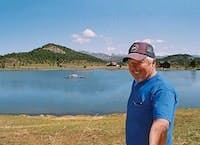Located in the high desert plateau of southwestern Colorado, Pagosa Springs is famous for its geothermal hot springs, which draw visitors worldwide to soak in the mineral-rich water. The Utes called the sulfur springs “Pah-gosah,” which means “healing waters.” One might say the town’s potable water system is healed now as well.
After first combating blue-green algae in the raw water reservoir and then thermal stratification in the storage tanks, Art Holloman, water superintendent for the Pagosa Area Water and Sanitation District (PAWSD), learned that SolarBee mixers, with their long-distance circulation technology, solve both types of problems. This solution helped PAWSD reduce operating costs, restore water quality and obtain accurate water sampling data.
First Problem Solved: High Cost of Copper Sulfate in Reservoir
The sanitation district relies on a series of raw water reservoirs for its potable water. One of them, the 130-acre Hatcher Reservoir, had a history of blue-green algae (BGA, or cyanobacteria) blooms, which caused taste and odor problems. The unsightly BGA also cost “a fortune” in copper sulfate and activated carbon filters, according to Holloman.
After learning about SolarBee mixers and consulting with Medora Corp.’s engineers and limnologists, PAWSD installed two SolarBee 10000v12 solar-powered units near the water treatment plant intake for partial-lake treatment. The blooms soon disappeared, as did concentrations of source water total organic carbon (TOC). To clear up the entire lake, PAWSD added three more SolarBee units.
“We have reduced copper sulfate treatments by 70%, and the taste and odor problems have disappeared,” said Holloman. In addition, TOC levels have decreased by about 1 to 2 mg/L. Based on this success, SolarBee units are now installed in four more lakes in the supply system.
Second Problem Solved: Thermal Stratification in Storage Tanks
PAWSD serves 12,000 residents via an 11-tank potable water storage and distribution system over 76 sq miles. Typical of unmixed tanks, thermal stratification and uneven water age made representative sampling unreliable for total chlorine monitoring. Holloman concentrated his resources and efforts on three tanks: Snowball, Stevens and Meadows. Stratification had created variable water age problems, including an increased risk of disinfection byproduct (DBP) violations.
The SolarBee mixers installed in each tank eliminated stratification. The Snowball tank was so successful it enabled the district to acquire contact time credits from the Colorado State Health Department to meet the Microscopic Particulate Analysis requirement. The other two tanks have shown consistent chlorine residuals and lower DBP (i.e., THM) concentrations.
Long Distance Mixing Solves Both Problems
Medora Corp.’s long-distance circulation and mixing technology pulls dense water from the level of the intake (typically near the thermocline in an open reservoir, or at the floor in a potable storage tank), transports it upward and then sends it out across the surface in thin, horizontal layers. In raw water reservoirs, the constant horizontal and vertical movement sufficiently disrupts large-celled BGA and allows “good” small-celled algae to predominate, restoring the food chain and returning the reservoir to a healthy state. In potable water storage tanks, the unique flow pattern in effect scrubs the floor and sides of the entire tank, constantly replacing disinfectant and killing the bacteria in the most critical parts of the tank.
For Pagosa Springs, healing its potable water system required a simple, single technology. Long-distance circulation and mixing provides a sustainable and cost-effective solution to blue-green algae in the reservoirs and essentially eliminates problems of thermal stratification and inconsistent chlorine residuals in the potable water storage tanks. Today, a total of 20 mixers in the lakes and tanks ensure the district’s water quality. As a result, “Our lakes are clear and our tanks are clean,” said Holloman.
Pat Schnaidt is vice president, marketing for Medora Corp. Schnaidt can be reached at [email protected] or 866.437.8076.



